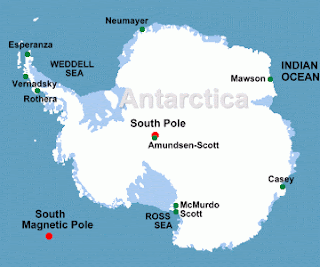"The words dinosaur and ice just don’t seem to go together. Dinosaurs and forests, yes. But not dinosaurs and ice. Yet the discovery of dinosaur fossils in Antarctica forces us to ask what extreme changes caused heat-loving dinosaurs to wind up on this ice-covered continent.
Antarctica... Winds there blow 200 miles per hour and temperatures regularly dip to -40°F. In fact, the continent of Antarctica, situated over the South Pole, is the coldest, windiest, and driest place on earth.
Yet a few hardy people have braved this forbidding land to look for fossils, and their findings are astonishing.
So far, eight dinosaur species have been found.
In 1991 a research team found another dinosaur in a Jurassic rock layer. Most of this specimen’s bones were found together, as they were in life, and about 7 feet away was a fossilized tree trunk. This dinosaur’s name, Cryolophosaurus, means “coldcrested lizard.”
Most creation geologists agree that Antarctica has not always been located where it is today. It broke off from a supercontinent during the Flood and moved like other continental fragments to its current location.
How can we know this? In addition to clues from fossils and rock layers, the magnetism of the rocks gives us clues. Since the magnetism in different rock layers in Antarctica points in different directions, it is possible the rocks hardened as the continent was moving southward across different latitudes!
There is good evidence that Antarctica was connected to Australia. For example, several geological details line up when these two continents are put back together. Yet the ocean floor between them does not have these features, indicating that the continents split apart." AIG
There were giants in the earth in those days;
Genesis 6:4
Antarctica... Winds there blow 200 miles per hour and temperatures regularly dip to -40°F. In fact, the continent of Antarctica, situated over the South Pole, is the coldest, windiest, and driest place on earth.
Yet a few hardy people have braved this forbidding land to look for fossils, and their findings are astonishing.
So far, eight dinosaur species have been found.
The first was Antarctopelta, meaning “Antarctic shield.” Discovered in 1986 among rocks assigned to the Upper Cretaceous, this find took scientists several field seasons to collect because of the difficult weather.
In 1991 a research team found another dinosaur in a Jurassic rock layer. Most of this specimen’s bones were found together, as they were in life, and about 7 feet away was a fossilized tree trunk. This dinosaur’s name, Cryolophosaurus, means “coldcrested lizard.”
Members of the same 1990–91 expedition also collected partial remains of another Jurassic creature called Glacialisaurus, meaning “frozen lizard.” The entire dinosaur must have been 20–25 feet long and weighed an estimated 4–6 tons. This is tentatively identified as a plant-eating, longnecked dinosaur, or sauropodomorph.
What did all these dinosaurs eat? Modern Antarctica has no trees or bushes, but in the dinosaurs’ rock layers we find lots of fossilized spores, ferns, pines, mosses, ginkgoes, and cycads. These plants obviously required temperatures much different from today’s temperatures.
Analysis of tree rings indicates that the trees enjoyed a more temperate climate, nothing like the polar regions today. For instance, the rings are ten times wider than those found in the trees of modern polar regions, and the fossilized trees did not have any “frost rings.”
How did all these fossilized ferns and dinosaur fossils wind up in such a different climate as the Antarctica of today?
Most creation geologists agree that Antarctica has not always been located where it is today. It broke off from a supercontinent during the Flood and moved like other continental fragments to its current location.
How can we know this? In addition to clues from fossils and rock layers, the magnetism of the rocks gives us clues. Since the magnetism in different rock layers in Antarctica points in different directions, it is possible the rocks hardened as the continent was moving southward across different latitudes!
There is good evidence that Antarctica was connected to Australia. For example, several geological details line up when these two continents are put back together. Yet the ocean floor between them does not have these features, indicating that the continents split apart." AIG
There were giants in the earth in those days;
Genesis 6:4
And all flesh died that moved upon the earth, both of fowl, and of cattle, and of beast, and of every creeping thing that creepeth upon the earth, and every man:
Genesis 7:21


